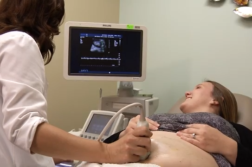CHICAGO. (Ivanhoe Newswire) — In vitro fertilization is no longer just for parents who have a hard time conceiving; it is now being used by parents who have a high likelihood of passing on a potentially debilitating genetic disease to their child. It’s a process called preimplantation genetic diagnosis. Doctors are testing for genetic diseases well before conception and giving parents peace of mind.
Twenty-two weeks into Jennifer St. Aubin’s pregnancy, she and her husband Peter received some very tough news. Their baby was diagnosed with polycystic kidney disease, or PKD.
“Nobody knew how serious it was going to be until she was actually born,” Jennifer told Ivanhoe.
Their daughter, Sophie, was born prematurely 15 weeks later. Due to PKD, her lungs had never fully developed. She died twelve hours after delivery.
“We were mourning Sophie, but we were also mourning the potential of never having a family,” detailed Jennifer.
That’s because Jennifer and Peter soon learned they were both carriers of the PKD gene. Even though they didn’t have the disease, they had a 25 percent likelihood of having another child with PKD.
Jennifer said, “If the IVF and the genetic testing weren’t in existence, I don’t think Pete and I would have chosen to have future children because of the risk of them being sick.”
The couple turned to Northwestern Medicine’s OBGYN Eve Feinberg, M.D., an expert in pre-implantation genetic diagnosis, or PGD.
“We then get a read out from the genetic testing laboratory that literally says embryo one unaffected, embryo two carrier, embryo three unaffected,” Dr. Feinberg told Ivanhoe. (Read Full Interview)
The St. Aubins opted for in vitro fertilization and had 20 embryos tested. Nine of them had PKD. Dr. Feinberg implanted one of the healthy embryos and …
“We are pregnant 26 weeks now with a girl,” said Jennifer.
A baby girl that doctors fully expect will be healthy.
Jennifer is due in October. A single attempt of in vitro fertilization using PGD can cost between $18,000-$20,000.
Contributors to this news report include: Cyndy McGrath, Supervising Producer; Jessica Sanchez, Field Producer; Milvionne Chery, Assistant Producer; Brent Sucher, Editor; Tony D’Astoli, Videographer.
MEDICAL BREAKTHROUGHS – RESEARCH SUMMARY
TOPIC: PGD to Select Healthy Embryos
REPORT: MB #4169
BACKGROUND: Preimplantation Genetic Diagnosis (PGD) is a procedure used prior to implantation to help identify genetic defects within embryos created through in vitro fertilization to prevent certain diseases or disorders from being passed on to the child. PGD begins with the normal process of in vitro fertilization which includes egg retrieval and fertilization in a laboratory. Over the next three days, the embryo will then divide into eight cells. PGD involves the four following steps. First, one or two cells are removed from the embryo. Second, the cells are then evaluated to determine if a problematic gene is present in the embryo. Once the PGD procedure has been performed and the embryos free of genetic problems have been identified, an embryo will be placed back into the uterus and then implantation will be attempted. Lastly, any additional embryos that are free of genetic problems may be frozen for later use while embryos with the problematic gene may be destroyed. The PGD procedure is recommended for couples who are at risk of transmitting a known genetic abnormality to their children. Healthy and normal embryos are transferred into the mother’s uterus thus diminishing the risk of inheriting a genetic abnormality and late pregnancy termination.
(Source: http://emedicine.medscape.com/article/273415-overview#a2 )
BENEFITS: Preimplantation genetic diagnosis can benefit any couple at risk for passing on a genetic disease or condition. These are the individuals who are eligible for PGD: carriers of sex-linked genetic disorders, carriers of single gene disorders, individuals with chromosomal disorders, women age thirty-five and over, women who experience recurring pregnancy loss, and women with more than one failed fertility treatment. PGD has also been used for the purpose of gender selection. The procedure is performed before implantation thus allowing the couple to decide if they wish to continue with the pregnancy. Lastly, the procedure enables couples to pursue biological children who might not have done so otherwise.
(Source: https://arm.coloradowomenshealth.com/services/ivf/pgd/risks/ )
CONCERNS: There are certain concerns and disadvantages that are associated with the use of PGD. Many people believe that because life begins at conception, the destruction of an embryo is the destruction of a person. While PGD helps to reduce the chances of conceiving a child with a genetic disorder, it cannot completely eliminate this risk. Although genetically present, some diseases only generate symptoms when carriers reach middle age. The probability of disorder development is a discussion to have with your healthcare provider. Also, it is important to keep in mind that PGD doesn’t replace the recommendation for prenatal testing.
(Source: https://arm.coloradowomenshealth.com/services/ivf/pgd/risks/ )
FOR MORE INFORMATION ON THIS REPORT, PLEASE CONTACT:
Sheila Galloro
Media Relations
773-717-9592
If this story or any other Ivanhoe story has impacted your life or prompted you or someone you know to seek or change treatments, please let us know by contacting Marjorie Bekaert Thomas at mthomas@ivanhoe.com




